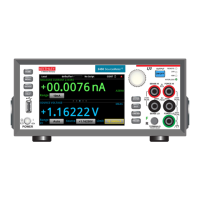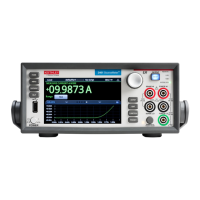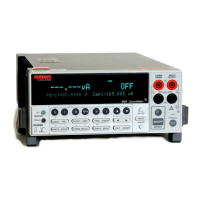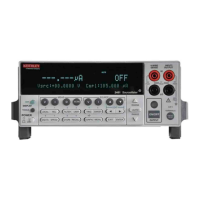Interactive SourceMeter® Instrument Reference Manual Section 3:
2450-901-01 Rev. B/September 2013 3-95
Trigger model
The trigger model controls the sequence in which measurements occur. The Model 2450 trigger
model is flexible, allowing you to control as much or as little as needed for your measurement
application.
When you are setting up a trigger model, you can choose the following options:
• Wait for an event to occur before taking another measurement
• Notify other equipment that an event has occurred
• Wait for another piece of equipment to signal completion
• Use measure configuration lists to apply different measurement settings dynamically during
trigger model operation
• Specify delays between events and measurements
• Use source configuration lists to sweep source settings and values
• Turn the source on and off with programmable delays to create pulses
• Store measurements into a given buffer until an event occurs, then switch to another buffer
• Conditionally take actions based on whether the measurement falls within set limits
Additional options are detailed in the following sections.
The Model 2450 includes predefined trigger models to allow you to quickly implement a trigger model.
You can also set up your own trigger models.
Trigger model building blocks
Each trigger model consists of building blocks that can be combined to create the trigger model. The
building blocks can be combined from the front panel or by sending remote commands. You can
connect the building blocks as needed to control the instrument.
You can combine trigger model building blocks as you would construct a flow chart diagram. Trigger
models are created using four fundamental building blocks:
• Wait: Waits for an event to occur before the flow continues
• Branch: Branches when a condition has been satisfied
• Action: Starts an action in the instrument, such as making a measurement or turning on a source
• Notify: Notifies other equipment that an event has occurred
Each type of building block is described in the following topics.
Reading-buffer clear building block
When the trigger model reaches the reading-buffer clear building block, the instrument empties a
reading buffer. The buffer can be the default buffer or a buffer that you defined. If you do not define a
buffer, the instrument clears the default buffer (defbuffer1).
Readings that are made after the buffer is cleared are added to the beginning of the buffer.
If you are defining a specific reading buffer, you must define it before you define this block. For more
information about reading buffers, see Reading buffers (on page 3-10
).
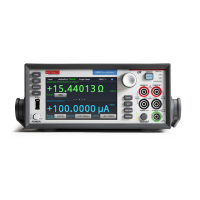
